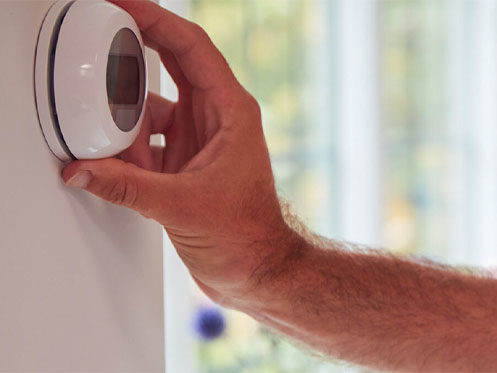Many homeowners don’t give much thought to where they place their thermostats. If nobody has told them otherwise, there’s really no reason to think it makes a difference one way or another. However, if your household utilizes a modern, smart thermostat, its specific placement can have a major impact on the way your home functions. The reason for this comes down to the way that thermostats do their jobs.
How Do Modern Thermostats Work?
These days, modern thermostats are capable of measuring the temperature of the air around them, and they do so to determine your heating or cooling needs. Then, once they’ve got a reading, they relay that information to your HVAC system.
Depending on the temperature that the thermostat registers and your preferred household climate, this relayed information will tell your heating and cooling systems what needs to be done. If your thermostat thinks it’s too warm, it will let your AC unit know that it needs to circulate cool air. If the thermostat thinks it’s too cold, then it’s your heating appliance that will be instructed to start working. This process will continue until your thermostat registers that your home has reached your preferred comfort level.
Why Does Thermostat Placement Make a Difference?
For your thermostat to do its job effectively and keep your household climate consistent, it needs to be located in a part of the home that enjoys steady temperatures. Additionally, the temperatures need to offer an accurate sample of the average temperature across the living space. Otherwise, your thermostat will experience what is referred to as a “ghost reading.”
In essence, a ghost reading simply means that your thermostat passed inaccurate information to your HVAC system. As a result of these ghost readings, your heating and cooling systems will likely be running either too frequently or not often enough. For example, if your thermostat thinks that your household is colder than it actually is, it will tell your heating unit to start distributing warm air. However, since you don’t actually need that warmth, your furnace will be straining itself unnecessarily, and your comfort will suffer. Plus, you’ll be wasting energy.
The Do’s and Don’ts of Thermostat Placement
Shortly, we’ll cover some of the best and worst locations for placing your thermostat. However, there are a few straightforward guidelines you should always remember when choosing the ideal spot. Perhaps the most important rule is to avoid areas that will regularly experience extreme temperatures or frequent temperature fluctuations. In those parts of your home, it will be very difficult for your thermostat to provide your HVAC system with accurate information.
You should always place your thermostat on an interior wall, and it should always be between 50 and 62 inches from the floor. Anywhere higher than that, and the readings will consistently be too warm due to the fact that heat rises. Anywhere below that, and the readings will typically be too cold. You should also try to keep the thermostat away from sections of the wall with supply ducts or plumbing pipes behind it. When air and water move through those ducts and pipes, the temperature can radiate through the wall and disturb the thermostat’s readings.
Great Choices for Thermostat Placement
The following parts of your household should serve well when it comes to accurate thermostat readings. In any of these locations, the operation of your HVAC system should be consistent, and you shouldn’t have any issue with keeping your living space comfortable.
Near the Middle of Your Home
Typically, anywhere in your home that paints an accurate picture of the home’s temperature is a good choice for thermostat placement. Usually, the temperature around the center of your household will be pretty close to the average temperature of your home. So, the odds of ghost readings will be significantly decreased, and your overall home climate should stay relatively consistent. Plus, each member of your family will have convenient access to the thermostat if they ever need to manually make adjustments.
On the First Floor of a Two-Story Home
If your home features two stories, you’d be wise to place your thermostat somewhere on the ground floor. Because warm air always rises, having the thermostat on the second floor will most likely lead to frequent high-temperature readings.
On the other hand, if your home is three stories high, the second floor may be the perfect place to set up your thermostat. In that case, the middle level of your home should provide the most accurate representation of the average household temperature.
However, if you want to control the climate of your multi-level household as effectively as possible, investing in a zoning system would be an excellent decision. That way, you’ll have the option to individually set the temperature of each section or floor of your home.
In a Room You Use Frequently
If there’s a room in which you and the other members of your household spend a lot of time, it could serve as a good spot for your thermostat. If it’s located in your favorite room, it will always receive its temperature readings based on the climate of that room. That way, even if the rest of the home has an uneven climate, the room that you and your family are occupying will remain consistent with your comfort preferences.
Bad Choices for Thermostat Placement
When looking for a proper thermostat location, you’d be smart to avoid any of the following places. In these areas, ghost readings will be frequent, and your comfort will be in jeopardy.
Near Doors or Windows
Ideally, your thermostat should be a healthy distance from any windows or doors that lead outside. If it’s located too close to a window, then it will encounter temperature fluctuations any time there’s a draft. If the window happens to contain any leaky spots, the nearby temperature will be even more inconsistent. As for doors, any time one of them opens, a significant amount of air blows in from outside. Unless the outside temperature is very close to the climate of your home, this will result in a ghost reading for your thermostat.
In the Kitchen
Although you may not think of your kitchen as a particularly warm part of the house, there’s a good chance that it’s one of the warmest. This is because every time you operate your oven or stove, the temperature in the kitchen rises significantly. So, if your thermostat is located in the kitchen, it will commonly think that your household is warmer than it is. As a result, your air conditioner will be instructed to run far more often than it should.
If you need to purchase a new thermostat or require expert heating, cooling, or indoor air quality services, our team at Dring Air Conditioning & Heating have you covered in the Carrollton, TX area. Since 1953, we’ve been a name that residents of this area trust for their home comfort needs. We’re a family-owned and -operated business going back seven generations. We’re the oldest service company in the Dallas area, and we operate on old-fashioned values that you can trust. When you’re ready to make an appointment, simply give us a call at Dring Air Conditioning & Heating!







